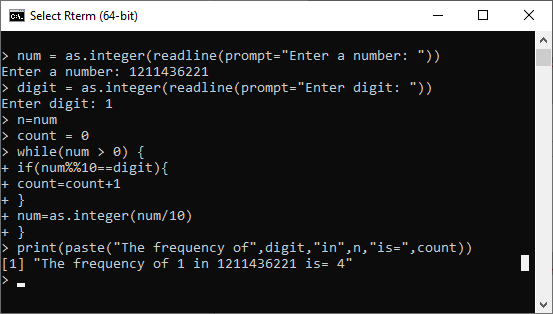



However, at each iteration you will also append your remaining debt total to a plot, so that you can visualize the total decreasing as you go.
While loop in r how to#
The following code illustrates how to write and use while-loops in R.Loops can be used for all kinds of fun examples! What if you wanted to visualize your debt decreasing over time? Like the last exercise, this one uses a loop to model paying it off, $500 at a time. This code is typically used when we don’t know the exact number of times our R code needs to be executed. While-loops repeat a code block as long as a certain logical condition is TRUE. Now, you could make the body of this for loop more complex to create more advanced outputs.Ĭlick here to find more detailed explanations and advanced programming examples of for-loops in R. the values 1 to 10).Īt this point, you basically know how to write and run a for-loop in the R programming language. The RStudio console output is showing the final outputs of our for-loop (i.e. Note that we have to use the print function to visibly return values within a for-loop. x_for + 1) and prints the updated data object to the RStudio console using the print function (i.e. The body of our for-loop adds +1 to our data object (i.e. About Press Copyright Contact us Creators Advertise Developers Terms Privacy Policy & Safety How YouTube works Test new features Press Copyright Contact us Creators. Also note that running indices can not be changed by the user within for-loops. Be careful, you must set an element on your loop to end it, otherwise you can create an infinite loop. As long as the condition is verified, the action on the loop is executed.

The condition is checked at the beginning of the loop. Note that our running index i is increased by 1 within each iteration. The while loop is a loop based on the respect of a condition. i) and the collection of objects through which we want to iterate (i.e. The head of our for-loop defines the running index (i.e. elements in a vector or list) to which a code block should be applied.Ī for-loop consists of two parts: First, a header that specifies the collection of objects Second, a body containing a code block that is executed once per object.įirst, we have to specify a data object that we can use within the for-loop: So keep on reading!įor-loops specify a collection of objects (e.g. In the following, I’ll explain the different types of loops and illustrate the differences in R programming example codes. The following graphic is illustrating the workflow of each of the three loop-types: The R programming language generally provides three different types of loops: for-loops, while-loops, and repeat-loops. The loop executes a code block again and again until no further action is required.Įach time the code block within the loop is executed is called an iteration.ĭepending on your specific programming situation, you may need different loop-structures that execute the code blocks within the loop on the basis of different conditions. 6) Advanced Tutorials on Loops What are Loops? Ī loop is a programming instruction that repeats until a specific condition is reached.


 0 kommentar(er)
0 kommentar(er)
